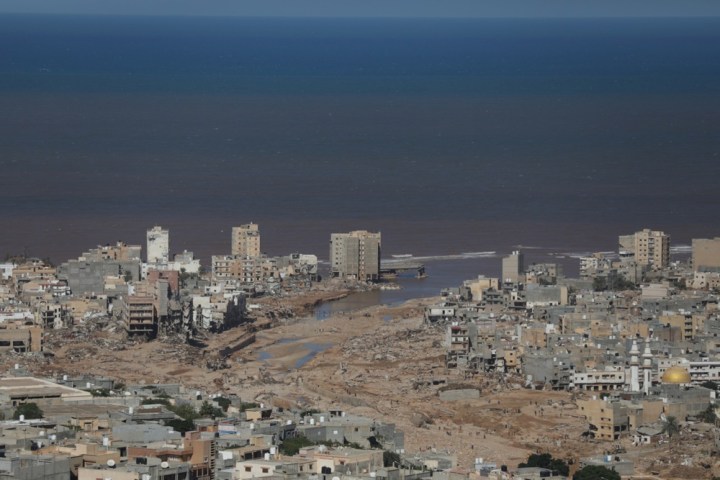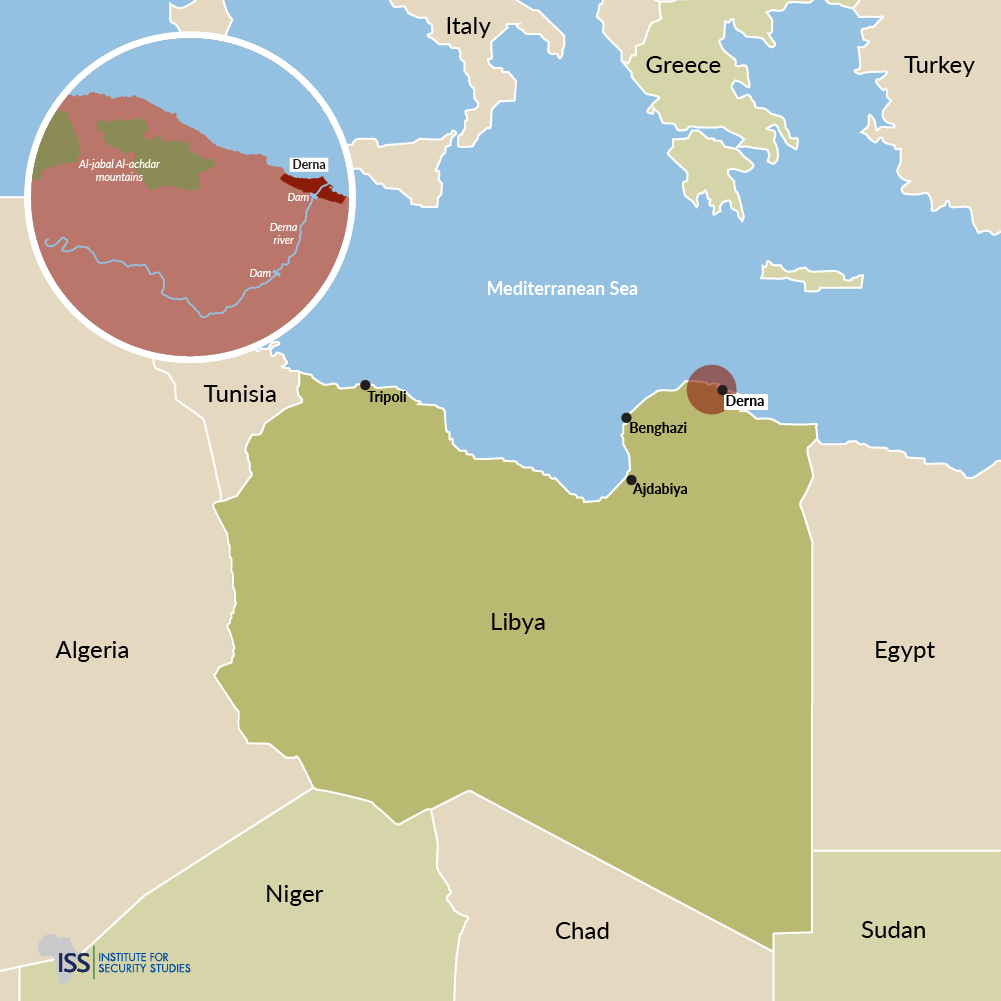ISS TODAY OP-ED
Libya floods worsened by opposing governance and poor climate change preparedness

The Derna disaster shows the lethal effect of a convergence between climate, governance and security threats.
The catastrophic flood last week in Derna, north-eastern Libya, has claimed the lives of 11 300 people. A significant number are still missing. Triggered by Storm Daniel, the event has sparked a humanitarian crisis and could worsen economic challenges over the long term.
Read more in Daily Maverick: Libya floods wipe out quarter of city, thousands dead
The devastation in Derna is a stark illustration of the convergence of multiple threats within the climate-development-security nexus, as highlighted by the African Union (AU) Peace and Security Council in 2021.
Storm Daniel, having caused major destruction in Greece, turned south-west over the Mediterranean Sea, which recorded its highest temperatures this year. The warmer water energised the storm, creating a medicane (Mediterranean hurricane) with higher moisture-carrying potential. After hitting Libya’s north-east coastline, the rainfall peaked on 10 September with a record-breaking 414.1 mm compared to the monthly average of less than 2 mm.

Derna in Libya — site of the flood triggered by Storm Daniel. (Graphic: Supplied by ISS Today)
In a country with no permanent rivers, the wadis (valleys) rapidly diverted the water flow downhill from the Al Jabal Al Akhdar Mountains towards Derna. Breaking through two dam walls, which were poorly maintained, the torrent inundated the city and its surroundings.
The disaster has various dimensions, with climate change particularly evident. Extreme weather events, with increased intensity and impact, have become more regular. While this is a worldwide phenomenon, there’s a huge difference between the developed and developing world.
In this instance, substantial data indicated a prolonged high precipitation period in the Mediterranean region for at least a week. So, the first lesson is the value of a robust early warning system, which Libya didn’t have. Such a system could have led to appropriate measures that would have reduced the casualties and damage. The United Nations (UN) Secretary-General’s vital Early Warnings for All initiative seeks to ensure that by 2027, early warning is operational worldwide.
The second lesson is the need for well-maintained infrastructure to mitigate the impacts of climate and other disasters. The two dams in the Derna system were built to control floods and supply water for irrigation. But their inappropriate 1970s design and lack of maintenance, despite repeated warnings, led to their collapse. This made the greater Derna area vulnerable to the equivalent of a land-based tsunami.
Conflicting governments, slow response
The third lesson is governance. Around a decade of civil war has led to Libya operating with two competing governments — the Tripoli-based UN-backed Government of National Unity with Prime Minister Abdul Hamid al-Dbeibeh, and the rival government in Benghazi led by Osama Hamad, backed by Khalifa Haftar. The division undermines governance in general, and has made it difficult for international aid to reach those affected by the flood.
Hamad was initially reluctant to accept aid from the government in Tripoli, creating delays. This has limited the operations of stable infrastructure to mitigate the disaster’s impact and implement disaster management measures and rescue operations before recovery and rebuilding begin.
Last week, reports from the International Organization for Migration put the number of displaced people at 30,000. The region is already a migration hotspot due to its proximity to Europe. At least 705,000 migrants of over 41 nationalities were in Libya in April this year. Approximately a third (235,132) were in eastern Libya, the location of the flood.
The largest share of migrants were from sub-Saharan Africa (49%) and North Africa (43%), with fewer from Middle East and Asian countries. Over a third (36%) had migrated due to livestock or crop losses in their home countries due to environmental factors, particularly droughts and floods in Sudan and Niger.
Due to the clandestine nature of irregular migration, it’s hard to know how many migrants were affected by Derna’s flood. According to the UN Refugee Agency, about 46,000 internally displaced people were in eastern Libya before the storm, including 2,800 in Derna, 3,100 in Ajdabiya, and 1,000 registered refugees and asylum seekers. The actual number will be considerably higher.
Irregular migrants are particularly vulnerable to climate shocks because they lack the livelihoods, assets and community support to build resilience. Migrants in affected cities will probably encounter heightened xenophobia as Libyan communities rebuild. Migrants are also less likely to be identified and have their remains returned home for burial.
Meanwhile, onward mobility remains near impossible. This disaster will further displace refugees and migrants to neighbouring countries, fuelling tensions and testing fragile relationships on migration matters.
Coming shortly after the AU’s inaugural Africa Climate Summit, the Derna flood reinforces the need to better understand the climate-development-security nexus. This natural catastrophe, intensified by the impact of climate change, was exacerbated by Libya’s limited development and ongoing security crisis. These interconnected issues will have a lasting effect during recovery and rebuilding.
Al Jazeera reports a potential move towards cooperation between the rival Tripoli and Benghazi governments to engineer more effective disaster management. As it helps Libya deal with the flood disaster, the international community could work to cement a more unified and stable country.
The hard road to recovery and rebuilding would benefit from a gesture from the big emitting and developed nations. This is an important example of the need for climate loss and damage assistance. Material contributions could create a positive atmosphere for negotiations on a loss and damage fund at the 2023 UN Climate Change Conference in Dubai later this year. DM
Dhesigen Naidoo, Senior Research Associate and Aimée-Noël Mbiyozo, Senior Research Consultant, Migration, Institute for Security Studies (ISS) Pretoria.
First published by ISS Today.



















 Become an Insider
Become an Insider
Comments - Please login in order to comment.